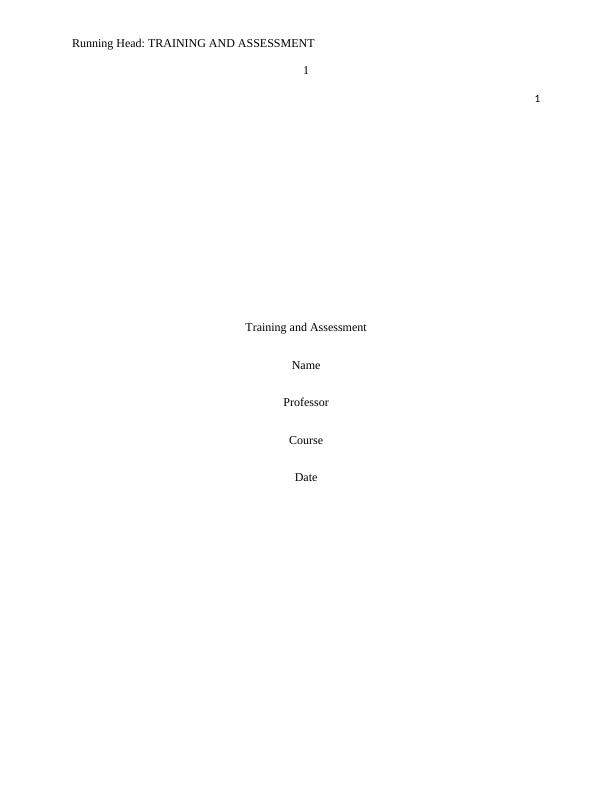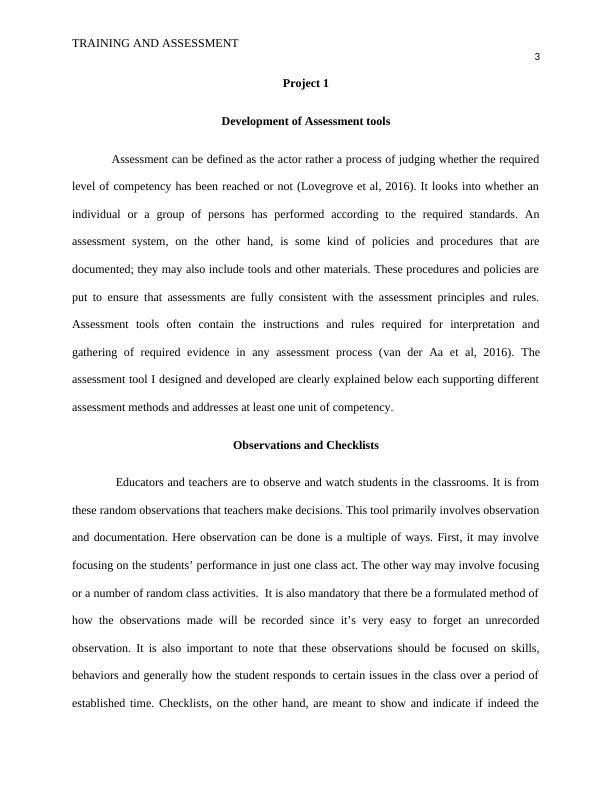Training and Assessment: Development of Assessment Tools and Plan and Organize Assessment
Added on 2023-06-10
19 Pages4985 Words105 Views
Running Head: TRAINING AND ASSESSMENT
1
1
Training and Assessment
Name
Professor
Course
Date
1
1
Training and Assessment
Name
Professor
Course
Date

TRAINING AND ASSESSMENT
2
Case study chosen for this assignment
The case study chosen for this assignment is case study 2. It is about Makoto Miyagi. He
was an automotive technology teacher for seven years before moving to Australia about two
years ago. He has been focusing on developing his English communication skills and also
completion for his qualification for AUR40616 Certificate IV in Automotive Electrical
Technology. He is actually aiming to work as an automotive electrical technology trainer in
Australia. Makoto has completed the lectures and the workshops too for design cluster which
covers the units outlined below;
1. TAEDES401 Design and development learning programs
2. TAEDES402 Use training packages and accredited courses to meet client needs
3. TAELLN411 Address adult language, literacy and numeracy skills
From the above Units Makoto is looking forward to take assessments and he has requested to
take the assessments on different dates.
Based on this case study, various assessment tools were developed as clearly shown in project 1.
An assessment for five candidates, Makoto being one of the candidates was planed and
organized where two of the assessments were RPL assessments and the other three were the
training and assessment pathway. Two assessment instruments were also developed covering the
two units chosen therein. This is done in project 2. Finally there is three validation sessions based
on Makoto case and these have been shown in project 3 (van der Aa et al, 2016).
2
Case study chosen for this assignment
The case study chosen for this assignment is case study 2. It is about Makoto Miyagi. He
was an automotive technology teacher for seven years before moving to Australia about two
years ago. He has been focusing on developing his English communication skills and also
completion for his qualification for AUR40616 Certificate IV in Automotive Electrical
Technology. He is actually aiming to work as an automotive electrical technology trainer in
Australia. Makoto has completed the lectures and the workshops too for design cluster which
covers the units outlined below;
1. TAEDES401 Design and development learning programs
2. TAEDES402 Use training packages and accredited courses to meet client needs
3. TAELLN411 Address adult language, literacy and numeracy skills
From the above Units Makoto is looking forward to take assessments and he has requested to
take the assessments on different dates.
Based on this case study, various assessment tools were developed as clearly shown in project 1.
An assessment for five candidates, Makoto being one of the candidates was planed and
organized where two of the assessments were RPL assessments and the other three were the
training and assessment pathway. Two assessment instruments were also developed covering the
two units chosen therein. This is done in project 2. Finally there is three validation sessions based
on Makoto case and these have been shown in project 3 (van der Aa et al, 2016).

TRAINING AND ASSESSMENT
3
Project 1
Development of Assessment tools
Assessment can be defined as the actor rather a process of judging whether the required
level of competency has been reached or not (Lovegrove et al, 2016). It looks into whether an
individual or a group of persons has performed according to the required standards. An
assessment system, on the other hand, is some kind of policies and procedures that are
documented; they may also include tools and other materials. These procedures and policies are
put to ensure that assessments are fully consistent with the assessment principles and rules.
Assessment tools often contain the instructions and rules required for interpretation and
gathering of required evidence in any assessment process (van der Aa et al, 2016). The
assessment tool I designed and developed are clearly explained below each supporting different
assessment methods and addresses at least one unit of competency.
Observations and Checklists
Educators and teachers are to observe and watch students in the classrooms. It is from
these random observations that teachers make decisions. This tool primarily involves observation
and documentation. Here observation can be done is a multiple of ways. First, it may involve
focusing on the students’ performance in just one class act. The other way may involve focusing
or a number of random class activities. It is also mandatory that there be a formulated method of
how the observations made will be recorded since it’s very easy to forget an unrecorded
observation. It is also important to note that these observations should be focused on skills,
behaviors and generally how the student responds to certain issues in the class over a period of
established time. Checklists, on the other hand, are meant to show and indicate if indeed the
3
Project 1
Development of Assessment tools
Assessment can be defined as the actor rather a process of judging whether the required
level of competency has been reached or not (Lovegrove et al, 2016). It looks into whether an
individual or a group of persons has performed according to the required standards. An
assessment system, on the other hand, is some kind of policies and procedures that are
documented; they may also include tools and other materials. These procedures and policies are
put to ensure that assessments are fully consistent with the assessment principles and rules.
Assessment tools often contain the instructions and rules required for interpretation and
gathering of required evidence in any assessment process (van der Aa et al, 2016). The
assessment tool I designed and developed are clearly explained below each supporting different
assessment methods and addresses at least one unit of competency.
Observations and Checklists
Educators and teachers are to observe and watch students in the classrooms. It is from
these random observations that teachers make decisions. This tool primarily involves observation
and documentation. Here observation can be done is a multiple of ways. First, it may involve
focusing on the students’ performance in just one class act. The other way may involve focusing
or a number of random class activities. It is also mandatory that there be a formulated method of
how the observations made will be recorded since it’s very easy to forget an unrecorded
observation. It is also important to note that these observations should be focused on skills,
behaviors and generally how the student responds to certain issues in the class over a period of
established time. Checklists, on the other hand, are meant to show and indicate if indeed the

TRAINING AND ASSESSMENT
4
student can accomplish the therein outlined and listed objectives. Here the quality of
performance is not mandatory, what is of importance is whether the student has the capability of
accomplishing the task (van der Aa et al, 2016).
It is also significant that the teacher predetermines the kind of skill and behavior that they
want to observe before designing the observation checklist (Lovegrove et al, 2016). The students
should be made aware of the skills and behaviors to be observed, this is not mandatory but it
provides these students with the appropriate guidelines for self-monitoring if need be. Another
important requirement for this assessment tool is that the teacher is expected to focus on a few
students at one particular time (Lovegrove et al, 2016). They may decide for instance t6o focus
on a section of the students in a class each day, but at long last, all the students should be
observed. Instructors and educators do watch and watch understudies in the classrooms. It is
from these irregular perceptions that educators decide. This apparatus principally includes
perception and documentation. Here perception should be possible is different of ways. To begin
with, it might include concentrating on the understudies' execution in only one class action. The
other way may include centering or various irregular class exercises. It is additionally obligatory
that there be figured technique on how the perceptions made will be recorded since it's anything
but difficult to overlook an unrecorded perception. It is likewise essential to take note of that
these perceptions ought to be centered on aptitudes, practices and by and large how the
understudy reacts to specific issues in the class over a time of set up time. Agendas then again
are intended to appear and demonstrate if in fact the understudy can achieve the in that plot and
recorded targets. Here the nature of execution isn't compulsory, what is of significance is
whether the understudy has the capacity of achieving the errand.
4
student can accomplish the therein outlined and listed objectives. Here the quality of
performance is not mandatory, what is of importance is whether the student has the capability of
accomplishing the task (van der Aa et al, 2016).
It is also significant that the teacher predetermines the kind of skill and behavior that they
want to observe before designing the observation checklist (Lovegrove et al, 2016). The students
should be made aware of the skills and behaviors to be observed, this is not mandatory but it
provides these students with the appropriate guidelines for self-monitoring if need be. Another
important requirement for this assessment tool is that the teacher is expected to focus on a few
students at one particular time (Lovegrove et al, 2016). They may decide for instance t6o focus
on a section of the students in a class each day, but at long last, all the students should be
observed. Instructors and educators do watch and watch understudies in the classrooms. It is
from these irregular perceptions that educators decide. This apparatus principally includes
perception and documentation. Here perception should be possible is different of ways. To begin
with, it might include concentrating on the understudies' execution in only one class action. The
other way may include centering or various irregular class exercises. It is additionally obligatory
that there be figured technique on how the perceptions made will be recorded since it's anything
but difficult to overlook an unrecorded perception. It is likewise essential to take note of that
these perceptions ought to be centered on aptitudes, practices and by and large how the
understudy reacts to specific issues in the class over a time of set up time. Agendas then again
are intended to appear and demonstrate if in fact the understudy can achieve the in that plot and
recorded targets. Here the nature of execution isn't compulsory, what is of significance is
whether the understudy has the capacity of achieving the errand.

End of preview
Want to access all the pages? Upload your documents or become a member.
